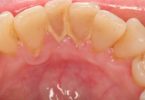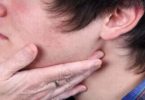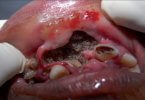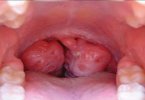What's in this article?
The teeth are the hardest substances in the human body. Besides being essential for chewing, the teeth play an important role in speech. Parts of the teeth include:
- Enamel: The hardest, white outer part of the tooth. Enamel is mostly made of calcium phosphate, a rock-hard mineral.
- Dentin: A layer underlying the enamel. Dentin is made of living cells, which secrete a hard mineral substance.
- Pulp: The softer, living inner structure of teeth. Blood vessels and nerves run through the pulp of the teeth.
- Cementum: A layer of connective tissue that binds the roots of the teeth firmly to the gums and jawbone.
- Periodontal ligament: Tissue that helps hold the teeth tightly against the jaw.
A normal adult mouth has 32 teeth, which (except for wisdom teeth) have erupted by about age 13:
- Incisors (8 total): The middlemost four teeth on the upper and lower jaws.
- Canines (4 total): The pointed teeth just outside the incisors.
- Premolars (8 total): Teeth between the canines and molars.
- Molars (8 total): Flat teeth in the rear of the mouth, best at grinding food.
- Wisdom teeth or third molars (4 total): These teeth erupt at around age 18, but are often surgically removed to prevent displacement of other teeth.
The crown of each tooth projects into the mouth. The root of each tooth descends below the gum line, into the jaw.
Different Kinds Of Teeth
Your teeth look different from one another because they are designed to do different things.
The Incisors are the teeth in the very front. They’re the sharpest teeth, built to cut food and shaped to shovel the food inward.
The Canine teeth are in the corners of your mouth. Because they’re meant for grasping and tearing food, they have very long roots.
Premolars are located just behind your Canine teeth. Premolars have a more flat chewing surface because they’re meant for crushing food.
The Molars are the last teeth towards the back of your mouth. Molars are much bigger than the Premolars and have bigger, flatter chewing surfaces because their job is to chew and grind the food into smaller pieces.
Problems of the Mouth and Teeth
Proper dental care including a good diet, frequent cleaning of the teeth after eating, and regular dental checkups is essential to maintaining healthy teeth and avoiding tooth decay and gum disease.
Disorders of the Teeth
Cavities and tooth decay. When bacteria and food particles stick to the teeth, plaque forms. The bacteria digest the carbohydrates in the food and produce acid, which dissolves the tooth’s enamel and causes a cavity. If the cavity isn’t treated, the decay process progresses to involve the dentine and pulp. Without treatment, serious infections can occur.
The most common ways to treat cavities and more serious tooth decay problems are: filling the cavity; performing root canal therapy, involving the removal of the pulp of a tooth; crowning a tooth with a cap that looks like a tooth made of metal, porcelain, or plastic; or removing and replacing the tooth.
A common cause of tooth decay in toddlers is “baby bottle tooth decay,” which occurs when a child goes to sleep with a milk or juice bottle in the mouth and the teeth are bathed in sugary liquid for an extended period of time. To avoid tooth decay and cavities, do not give your child a bottle when going to sleep. Also, teach your kids good dental habits including proper tooth-brushing techniques at an early age.
Impacted wisdom teeth. In many people, the wisdom teeth are unable to erupt normally so they either remain below the jawline or don’t grow in properly. Dentists call these teeth impacted. Wisdom teeth usually become impacted because the jaw isn’t large enough to accommodate all the teeth that are growing in and the mouth becomes overcrowded. Impacted teeth can damage other teeth or become painful and infected.
Dentists can check if a person has impacted wisdom teeth by taking X-rays of the teeth. If the X-rays show there’s a chance that impacted teeth may cause problems, the dentist may recommend that the tooth or teeth be extracted.
Malocclusion is the failure of the teeth in the upper and lower jaws to meet properly. Types of malocclusion include overbite, underbite, and crowding. Most conditions can be corrected with treatment such as braces, which are metal or clear ceramic brackets bonded to the front of each tooth. The wires connecting braces are tightened periodically to force the teeth to move into the correct position. There are also ways to correct the bite using removable clear appliances.
Teeth Treatments
Brushing teeth: Daily brushing of the teeth removes plaque and prevents cavities.
Flossing teeth: Using floss or an approved dental gum cleaner cleans teeth below the gum line, where brushing cannot reach.
Rinsing teeth: Rinsing daily with an antiseptic mouthwash kills bacteria that cause bad breath and gum disease.
Teeth cleaning: Professional teeth cleaning every six months may help prevent teeth and gum disease.
Tooth filling: Drilling out the diseased part of a tooth and packing the space with a mineral filling can prevent a cavity from destroying the tooth.
Root canal: The deep pulp of a tooth is drilled out, cleaned, and filled. A root canal is done when damage to the teeth has affected the deep pulp.
Tooth extraction: If a tooth is too damaged to repair with a filling or root canal, it may be removed. Wisdom teeth are often extracted to prevent displacement of the other teeth.
Braces: An artificial device or system that places teeth under tension for a long period of time. Eventually, braces can help crooked teeth become realigned.
Mouth guard: A plastic mouthpiece can provide protection from teeth grinding and injury during sports.
Dental sealants: A plastic sealant applied to the teeth can help block bacteria from hiding in crevices on teeth surfaces. Sealants can help prevent cavities.
Teeth whitening: Over-the-counter and professional chemical treatments can bleach teeth to a brighter white. Tooth sensitivity is the most common side effect.






Leave a Comment